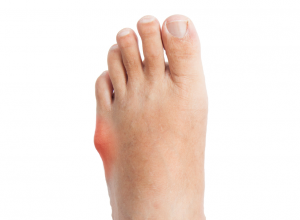
Bunionette (Tailor’s Bunion)
A bunionette, sometimes referred to as a tailor's bunion, is a deformity characterized by the enlargement of bone or tissue around the metatarsophalangeal joint at the base of the little (pinky) toe. They are less common than bunions, which affect the joint at the base of the big toe, but they are similar in symptoms as well as causes.
Symptoms
A tailor’s bunion forms when the long bone that connects to the fifth metatarsal bone (the little toe) begins to shift outward, creating a bony enlargement that appears as a bump on the outside (lateral) part of your foot. The bony protrusion is usually a progressive problem that starts off as a painless bump that slowly increases in size, redness and pain, the latter of which is exacerbated when wearing shoes. Bunionettes may also be swollen due to shoes rubbing against the bump and creating inflammation.
Some people may develop corns and calluses between the fourth and fifth toes due to the toes tightly pressing and rubbing together. In some cases, tailor’s bunions cause bursitis, which is painful inflammation of the fluid-filled pads that cushion your bones. In other cases, the bunionette causes a change in gait, which can then cause pain in the legs, knees, hips and back.
Causes
As with regular bunions, experts believe that bunionettes form from a combination of both genetics and wearing tight, tapered or improperly fitted shoes. Other causes of tailor’s bunions include foot injuries, rheumatoid arthritis and deformities like flatfoot that cause biomechanical abnormalities in the function of the foot.
In some cases, the bony protrusion is actually a bone spur (also called an osteophyte), which is an outgrowth of bone found along joint margins. Osteophytes grow as part of your body’s way of protecting itself from rubbing, pressure, irritation or other stresses that affect the joint over long periods of time. This is how tailor’s bunions got their name centuries ago: Tailors used to sit cross-legged all day with the outside of their feet rubbing on the ground. The constant rubbing caused irritation, and the body began producing extra bone as a way to protect the foot.
Treatment
As with regular bunions, bunionettes rarely need surgery. Most cases can be eased with simple treatments like wearing wider shoes with large toe boxes, applying padding to the area that causes pain and opting for orthotic devices.
Other options to help ease the pain and discomfort caused by tailor’s bunions are injections of corticosteroid to treat the inflammation, ice to help with swelling and nonsteroidal anti-inflammatory drugs (NSAIDs) to help with the pain.
Surgery is considered a last option and, as websites like WebMD and MedScape state, is only recommended if the above methods don’t help manage the pain. Your podiatrist, orthopaedic surgeon or foot and ankle doctor can help you determine if a surgical procedure called an osteotomy (which is cutting a bone to shorten it, lengthen it, or change its alignment) is the right option for you, or if other surgical procedures are better. Typically, surgeries that treat bunionettes involve cutting the metatarsal bones, realigning them and then reattaching the bones with screws, wires and pins.
Notice concerning medical entries:
Articles having medical content shall serve exclusively for the purpose of general information. Such articles are not suitable for any (self-) diagnosis and treatment of individual illnesses and medical indications. In particular, they cannot substitute for the examination, advice, or treatment by a licensed physician or pharmacist. No replies to any individual questions shall be effected through the articles.







